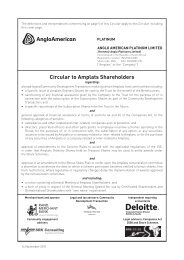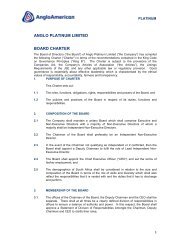ore reserves and mineral resources 2011 report - Anglo American ...
ore reserves and mineral resources 2011 report - Anglo American ...
ore reserves and mineral resources 2011 report - Anglo American ...
You also want an ePaper? Increase the reach of your titles
YUMPU automatically turns print PDFs into web optimized ePapers that Google loves.
SECURING OUR FUTURE<br />
ORE RESERVES AND MINERAL RESOURCES<br />
MINERAL RESOURCES<br />
The platinum group metal (PGM) Mineral Resources of <strong>Anglo</strong><br />
<strong>American</strong> Platinum Limited (Amplats) occur almost exclusively<br />
within southern Africa, <strong>and</strong> are hosted by two distinct but unique<br />
ultramafic layered intrusions: the Bushveld Complex in South Africa<br />
<strong>and</strong> the Great Dyke in Zimbabwe.<br />
Total PGM Resources present within these two geological features<br />
account for approximately 85% of the world’s known platinum <strong>and</strong><br />
55% of the world’s known palladium.<br />
THE BUSHVELD COMPLEX<br />
The Bushveld Complex is geologically unique owing to its size,<br />
uniform layering <strong>and</strong> <strong>mineral</strong> content. Formed over two billion years<br />
ago from multiple injections of molten magma into the earth’s crust<br />
many kilometres below the earth’s surface, the resultant saucershaped<br />
intrusion is over 350 kilometres wide, 250 kilometres long<br />
<strong>and</strong> up to 12 kilometres thick. Over many millions of years the rim of<br />
the intrusion has been exposed by erosion, revealing three separate<br />
segments known as the Western, Eastern <strong>and</strong> Northern limbs<br />
respectively. The exposed segments exhibit layering of different rock<br />
types (such as pyroxenites, norites, gabbros <strong>and</strong> chromitites) <strong>and</strong><br />
this layering occurs across the entire extent of the complex. Within<br />
the layers, <strong>mineral</strong>isation is found within specific horizons containing<br />
economic <strong>mineral</strong>s that host chromite, titanium, vanadium, nickel,<br />
copper <strong>and</strong>, m<strong>ore</strong> importantly for Amplats, the platinum group<br />
metals or PGMs.<br />
Economic concentrations of PGMs occur within three distinct reefs<br />
within the Bushveld Complex: the Merensky Reef, the Upper Group<br />
2 (UG2) Chromitite <strong>and</strong> the Platreef. The Merensky Reef <strong>and</strong> the<br />
UG2 Reef occur around the Eastern <strong>and</strong> Western limbs of the<br />
complex, while the Platreef is found only along the eastern edge of<br />
the Northern Limb.<br />
The Merensky Reef <strong>and</strong> the UG2 Reef<br />
The Merensky <strong>and</strong> UG2 reefs are narrow tabular <strong>ore</strong>bodies that<br />
extend laterally over hundreds of square kilometres, resulting in<br />
extensive Mineral Resources. Their continuity, established over<br />
years of exploration <strong>and</strong> mining, allows for long-range extrapolation<br />
of data. The Merensky Reef has been the principal source of PGMs<br />
since it was first mined in 1925. However, with the depletion of<br />
shallow Merensky Resources the UG2 Reef, which is found at a<br />
vertical distance of between 16 <strong>and</strong> 400 metres below the Merensky<br />
Reef depending on the location, has grown steadily in importance to<br />
the point where it now accounts for m<strong>ore</strong> than 50% of all the<br />
platinum-bearing <strong>ore</strong> processed in South Africa.<br />
The Platreef<br />
On the Northern Limb of the Bushveld, the Merensky <strong>and</strong> UG2 reefs<br />
are not developed on Amplats’ properties. However, the Platreef,<br />
which is substantially thicker than either the Merensky Reef or the<br />
UG2 Reef, is well developed. The Platreef was mined briefly in the<br />
1920s, but has been exploited on a large scale only since 1993. It is<br />
gradually becoming a significant contributor of PGMs for Amplats.<br />
The term ‘Platreef’ describes zones of <strong>mineral</strong>isation occurring in a<br />
variety of rocks that range from normal pyroxenites to calcsilicates<br />
that have arisen through the contamination of Bushveld magma by<br />
sediments from the underlying Transvaal Supergroup. In general,<br />
the economic thickness of the Platreef is such that it can support<br />
open-pit mining operations to depths well in excess of 200 metres at<br />
current prices <strong>and</strong> mining costs.<br />
Base metal <strong>mineral</strong>isation<br />
The Merensky Reef <strong>and</strong> the Platreef yield meaningful quantities of<br />
nickel <strong>and</strong> copper as by-products of PGMs, whereas the UG2 Reef is<br />
relatively devoid of these metals. Although chromitite contained in<br />
the UG2 has potential for economic gain <strong>and</strong> in some areas is being<br />
exploited as a by-product, Amplats has not considered this when<br />
measuring the reef’s contained monetary values for Ore Reserve<br />
purposes. However, other UG2 base metals have been considered,<br />
<strong>and</strong> their value has been accounted for in the relevant economic<br />
evaluations.<br />
THE GREAT DYKE<br />
The Great Dyke is located in Zimbabwe <strong>and</strong> occurs as a major<br />
intrusion that trends in a north-easterly direction <strong>and</strong> is over<br />
500 kilometres in length. It comprises mafic <strong>and</strong> ultramafic rocks<br />
that cut across the dominantly Achaean rocks of the Zimbabwe<br />
Craton, consisting mostly of granite <strong>and</strong> greenstone belt rocks. PGM<br />
<strong>and</strong> associated base metal <strong>mineral</strong>isation is developed within a<br />
mafic/ultramafic horizon <strong>and</strong> covers over 720 square kilometres of<br />
the Great Dyke.<br />
4 ANGLO AMERICAN PLATINUM LIMITED <strong>2011</strong>



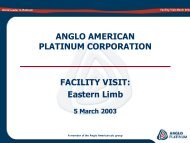
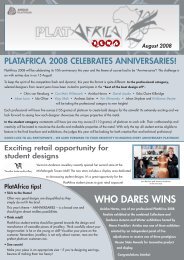
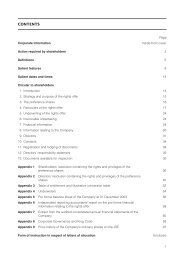

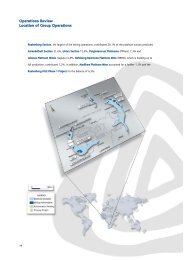

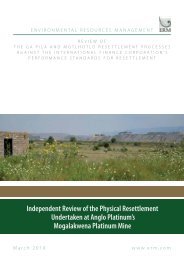

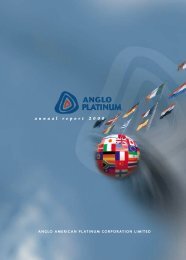
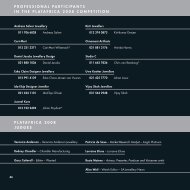
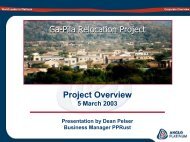
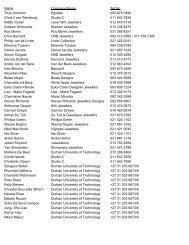
![[PDF] Mogalakwena Mine - Anglo Platinum](https://img.yumpu.com/43065142/1/184x260/pdf-mogalakwena-mine-anglo-platinum.jpg?quality=85)
